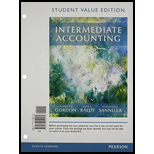
1.
The composition of investment in the firm’s portfolio of held-to-maturity, trading and available for sale in the year 2013 and 2012, the percentage of investment to total asset and comment on changes.
2.
The investment security reported at fair value in 2013 and 2012 and difference between fair value and cost value.
3.
The effect of change in fair value on net income in 2013, 2012 and 2011; and the effect on net income if unrealized gain and losses reported in the net income instead of other comprehensive income.
4.
The type and amount of investment in each level of security in fiscal year 2013.
5.
To explain: The valuation method used and comment on any assumptions and estimates used in the valuation.
6.
To explain: The reason because of which Company C is concerned about the harm to earnings when changes in fair value of securities are reported in other comprehensive income.
Want to see the full answer?
Check out a sample textbook solution
Chapter 16 Solutions
Intermediate Accounting - Myaccountinglab - Pearson Etext Access Card Student Value Edition
- On May 1st, Golden Harvest, Inc. purchased $1,500 worth of supplies on account. On December 31st, the fiscal year-end for Golden Harvest, it is determined that $800 worth of supplies still remain. What is the balance in the supplies account after adjustment?arrow_forwardI want to correct answer general accounting questionarrow_forwardWhat is the total stockholder's equity on these financial accounting question?arrow_forward
- What is the amount of overhead allocated to job 8- 17?arrow_forwardHawk, Inc. reported on its 2022 Statement of Cash Flows that it paid $95,400 for interest. The company reported $107,200 of Interest Expense on the 2022 Income Statement. The balance in Interest Payable on the 2022 Balance Sheet was $16,800. What was the balance in Interest Payable on the 2021 Balance Sheet? a) $5,000 b) $6,400 c) $16,800 d) $27,000 e) Unable to tell from the information given.arrow_forwardNeed help with this question solution general accountingarrow_forward

 AccountingAccountingISBN:9781337272094Author:WARREN, Carl S., Reeve, James M., Duchac, Jonathan E.Publisher:Cengage Learning,
AccountingAccountingISBN:9781337272094Author:WARREN, Carl S., Reeve, James M., Duchac, Jonathan E.Publisher:Cengage Learning, Accounting Information SystemsAccountingISBN:9781337619202Author:Hall, James A.Publisher:Cengage Learning,
Accounting Information SystemsAccountingISBN:9781337619202Author:Hall, James A.Publisher:Cengage Learning, Horngren's Cost Accounting: A Managerial Emphasis...AccountingISBN:9780134475585Author:Srikant M. Datar, Madhav V. RajanPublisher:PEARSON
Horngren's Cost Accounting: A Managerial Emphasis...AccountingISBN:9780134475585Author:Srikant M. Datar, Madhav V. RajanPublisher:PEARSON Intermediate AccountingAccountingISBN:9781259722660Author:J. David Spiceland, Mark W. Nelson, Wayne M ThomasPublisher:McGraw-Hill Education
Intermediate AccountingAccountingISBN:9781259722660Author:J. David Spiceland, Mark W. Nelson, Wayne M ThomasPublisher:McGraw-Hill Education Financial and Managerial AccountingAccountingISBN:9781259726705Author:John J Wild, Ken W. Shaw, Barbara Chiappetta Fundamental Accounting PrinciplesPublisher:McGraw-Hill Education
Financial and Managerial AccountingAccountingISBN:9781259726705Author:John J Wild, Ken W. Shaw, Barbara Chiappetta Fundamental Accounting PrinciplesPublisher:McGraw-Hill Education





